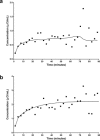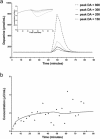Voxelwise lp-ntPET for detecting localized, transient dopamine release of unknown timing: sensitivity analysis and application to cigarette smoking in the PET scanner
- PMID: 24700424
- PMCID: PMC4303353
- DOI: 10.1002/hbm.22519
Voxelwise lp-ntPET for detecting localized, transient dopamine release of unknown timing: sensitivity analysis and application to cigarette smoking in the PET scanner
Abstract
The "linear parametric neurotransmitter PET" (lp-ntPET) model estimates time variation in endogenous neurotransmitter levels from dynamic PET data. The pattern of dopamine (DA) change over time may be an important element of the brain's response to addictive substances such as cigarettes or alcohol. We have extended the lp-ntPET model from the original region of interest (ROI) - based implementation to be able to apply the model at the voxel level. The resulting endpoint is a dynamic image, or movie, of transient neurotransmitter changes. Simulations were performed to select threshold values to reduce the false positive rate when applied to real (11)C-raclopride PET data. We tested the new voxelwise method on simulated data, and finally, we applied it to (11)C-raclopride PET data of subjects smoking cigarettes in the PET scanner. In simulation, the temporal precision of neurotransmitter response was shown to be similar to that of ROI-based lp-ntPET (standard deviation ∼ 3 min). False positive rates for the voxelwise method were well controlled by combining a statistical threshold (the F-test) with a new spatial (cluster-size) thresholding operation. Sensitivity of detection for the new algorithm was greater than 80% for the case of short-lived DA changes that occur in subregions of the striatum as might be the case with cigarette smoking. Finally, in (11)C-raclopride PET data, DA movies reveal for the first time that different temporal patterns of the DA response to smoking may exist in different subregions of the striatum. These spatiotemporal patterns of neurotransmitter change created by voxelwise lp-ntPET may serve as novel biomarkers for addiction and/or treatment efficacy.
Keywords: dopamine; lp-ntPET; nicotine; sensitivity; time-varying parameters; voxel analysis.
Copyright © 2014 The Authors. Human Brain Mapping Published by Wiley Periodicals, Inc.
Figures












Similar articles
-
Sex differences in the brain's dopamine signature of cigarette smoking.J Neurosci. 2014 Dec 10;34(50):16851-5. doi: 10.1523/JNEUROSCI.3661-14.2014. J Neurosci. 2014. PMID: 25505336 Free PMC article.
-
Creating dynamic images of short-lived dopamine fluctuations with lp-ntPET: dopamine movies of cigarette smoking.J Vis Exp. 2013 Aug 6;(78):50358. doi: 10.3791/50358. J Vis Exp. 2013. PMID: 23963311 Free PMC article.
-
A framework for designing dynamic lp-ntPET studies to maximize the sensitivity to transient neurotransmitter responses to drugs: Application to dopamine and smoking.Neuroimage. 2017 Feb 1;146:701-714. doi: 10.1016/j.neuroimage.2016.10.019. Epub 2016 Oct 13. Neuroimage. 2017. PMID: 27743899 Free PMC article.
-
Toward whole-brain dopamine movies: a critical review of PET imaging of dopamine transmission in the striatum and cortex.Brain Imaging Behav. 2019 Apr;13(2):314-322. doi: 10.1007/s11682-017-9779-7. Brain Imaging Behav. 2019. PMID: 29071465 Free PMC article. Review.
-
Modeling PET Data Acquired During Nonsteady Conditions: What If Brain Conditions Change During the Scan?J Nucl Med. 2024 Dec 3;65(12):1824-1837. doi: 10.2967/jnumed.124.267494. J Nucl Med. 2024. PMID: 39448268 Free PMC article. Review.
Cited by
-
Sex differences in the nicotinic acetylcholine and dopamine receptor systems underlying tobacco smoking addiction.Curr Opin Behav Sci. 2018 Oct;23:196-202. doi: 10.1016/j.cobeha.2018.04.004. Epub 2018 Apr 26. Curr Opin Behav Sci. 2018. PMID: 31341936 Free PMC article.
-
Sex differences in the brain's dopamine signature of cigarette smoking.J Neurosci. 2014 Dec 10;34(50):16851-5. doi: 10.1523/JNEUROSCI.3661-14.2014. J Neurosci. 2014. PMID: 25505336 Free PMC article.
-
PET Neurochemical Imaging Modes.Semin Nucl Med. 2016 Jan;46(1):20-7. doi: 10.1053/j.semnuclmed.2015.09.001. Semin Nucl Med. 2016. PMID: 26687854 Free PMC article. Review.
-
Model Comparison Metrics Require Adaptive Correction if Parameters Are Discretized: Proof-of-Concept Applied to Transient Signals in Dynamic PET.IEEE Trans Med Imaging. 2020 Jul;39(7):2451-2460. doi: 10.1109/TMI.2020.2969425. Epub 2020 Feb 5. IEEE Trans Med Imaging. 2020. PMID: 32031932 Free PMC article.
-
Methods for Quantifying Neurotransmitter Dynamics in the Living Brain With PET Imaging.Front Physiol. 2020 Jul 21;11:792. doi: 10.3389/fphys.2020.00792. eCollection 2020. Front Physiol. 2020. PMID: 32792972 Free PMC article. Review.
References
-
- Alpert NM, Badgaiyan RD, Livni E, Fischman AJ (2003): A novel method for noninvasive detection of neuromodulatory changes in specific neurotransmitter systems. Neuroimage 19:1049–1060. - PubMed
-
- Brody AL, Olmstead RE, London ED, Farahi J, Meyer JH, Grossman P, Lee GS, Huang J, Hahn EL, Mandelkern MA (2004): Smoking‐induced ventral striatum dopamine release. Am J Psychiatry 161:1211–1218. - PubMed
-
- Brody AL, Mandelkern MA, Olmstead RE, Scheibal D, Hahn E, Shiraga S, Zamora‐Paja E, Farahi J, Saxena S, London ED, McCracken JT (2006): Gene variants of brain dopamine pathways and smoking‐induced dopamine release in the ventral caudate/nucleus accumbens. Arch Gen Psychiatry 63:808–816. - PMC - PubMed
-
- Carson RE, Barker WC, Liow JS, Johnson CA (2003): Design of a motion‐compensation OSEM list‐mode algorithm for resolution‐recovery reconstruction for the HRRT In: IEEE Nuclear Science Symposium Conference Record, IEEE, Portland, OR, Vol. 1–5 pp. 3281–3285.
Publication types
MeSH terms
Substances
Grants and funding
LinkOut - more resources
Full Text Sources
Other Literature Sources

